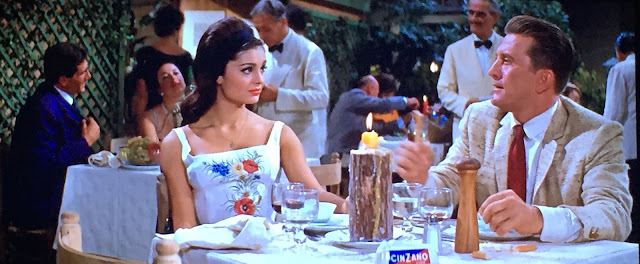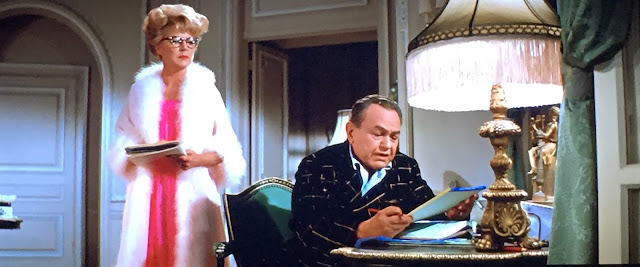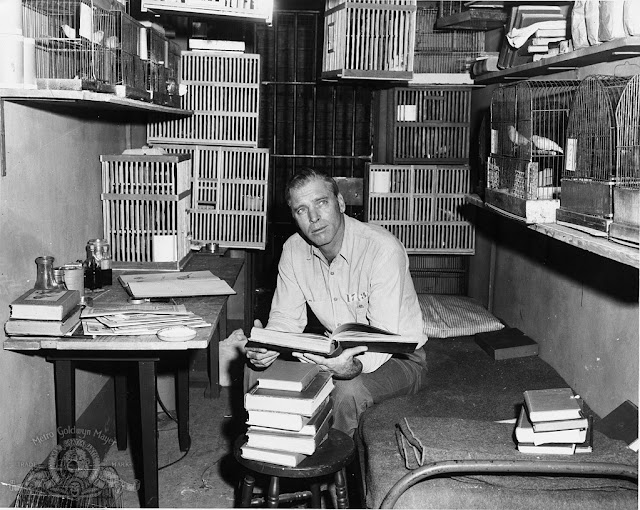"I don't think Paul Newman really thinks he is Paul Newman in his head." William Goldman
Harper (1966)
Paul Newman needed something to get him out of his funk. He was in the midst of a box office drought and the movie he was currently working on was turning out to be a disaster. The year was 1965 and Newman was filming
Lady L (1965) in Paris. Newman's part was seriously lacking and he wasn't getting on with his director Peter Ustinov or his leading lady Sophia Loren. Meanwhile, producer Elliot Kastner had a part that seemed perfect for Newman. He flew to Paris to present Newman the script. Newman liked it and was on board with the project. Then Kastner hit a bit of a snag. His director wanted to make some changes that would change what Newman liked about the script. Newman was far too valuable to the project and the director simply was not. So Kastner fired him and hired Jack Smight to take over.
William Goldman, a novelist who was new to the movie business, wrote said script. Goldman met Kastner when the producer optioned his novel
Boys and Girls Together. Goldman suggested to Kastner they should make a movie out of Ross Macdonald's detective story
The Moving Target, originally published in 1949. Macdonald's book was the first in a series of novels following the adventures of private investigator Lew Archer. The series was so popular that by 1965 he had already published 12 installments. In his lifetime Macdonald wrote 18 Lew Archer mysteries, ranging in publication from 1949 to 1976, and a handful of short story collections. For the role of Lew Archer, the first actor that came to mind was Frank Sinatra. But he turned down the part. Next on the list Paul Newman who seemed an even better fit than Sinatra. Newman would be perfect for the part especially when the 1949 novel was updated with a cool swinging 1960s sensibility. Writer Goldman was new and willing to please. And this came in handy for Kastner when Newman had one big change he wanted to make to his character.
Newman really needed this project to revive his career. He had just turned 40 and knew if he didn't turn things around his career could go south quickly. The letter H had been lucky for Newman. Both
The Hustler (1961) and
Hud (1963) served him well and he had to keep that moment going. And that meant Lew Archer had to become Lew Harper. With the name change, Newman could make this character his own. Newman might not have been right for Lew Archer but Lew Harper would fit him like a glove. Newman embodied the charismatic anti-hero, a character type he had done well with before and after. By the mid 1960s, after countless James Bond spin-offs, the film industry was suffering from spy movie fatigue. Going back to the tried and true private eye detective story was a sound decision. But Newman had to make one big concession to take on the role. Back in 1959, Newman butted heads with Jack Warner and acrimoniously parted ways with Warner Bros. Newman wanted the role of Harper badly enough that he conceded to go back to his old studio. A big pay day ($500k or $750k against 10 percent gross, depending on the source) made the decision easier to swallow. According to biographer Shawn Levy, Newman once told a reporter "A feud should live a full and colorful life and then it should die a natural death and be forgotten."
The movie was simply called
Harper (1966) and production ran from June to August 1965. As further insurance for the movie's success, actress Lauren Bacall was hired to play the role of Mrs. Sampson, the rich housewife who hires Lew Harper to find her missing husband. Her presence in the film connects it to the bygone era of classic detective novels and movies. Especially Raymond Chandler's
The Big Sleep, in which she starred with husband Humphrey Bogart in the movie adaptation. Also in the cast of
Harper was Julie Harris who played the drug addicted lounge pianist, Pamela Tiffin, Mrs. Sampson's beautiful and manipulative step-daughter, Arthur Hill, Harper's friend and the Sampson family lawyer, Robert Wagner, the family's personal airplane pilot and Shelley Winters, the aging movie star. Janet Leigh played Harper's soon-to-be ex-wife, a character not in the original novel but would add some romantic angst to the plot and more star power to the movie.
Even with all the big names on board, this was Paul Newman's film. Newman honed the Harper character in such a way that according to writer Christine Becker he "reaffirmed his rebel cool status." He modeled some of the mannerisms after Robert F. Kennedy. According to Newman biographer Shawn Levy, Kennedy "had a habit of standing beside people and looking away from them with his head titled when listening to them. It was a weird sort of engaged non-engagement and it fit the character beautifully."
Harper (1966) was a big hit with audiences and Warner Bros. turned a nice profit with their $2 million movie. According to another Newman biographer, Marian Edelman, "the public loved
Harper, and it put Paul Newman back on the top-10 list of box-office stars of the year." The critics were more hesitant about the movie's value but it didn't matter. Newman was back on top. Warner Bros. capitalized on Newman using taglines and slogans like "Paul Newman is Harper", "Excitement clings to him like a dame" and "Girls go for Harper." Perhaps Frank Sinatra, seeing the success of Newman in Harper, changed his mind about making a detective movie. He would go on to play private eye in
Tony Rome (1967) and
A Lady in Cement (1968).
Harper also did wonders for screenwriter William Goldman's career. According to Lawrence J. Quirk, "Goldman came through and the success of
Harper put him on the map." And by the time
Harper was released, Ross Macdonald had published book #13 in the Lew Archer series,
Black Money, which got a boost from the film. This made up for the mere $12,500 he received from the film.
After
Harper, Newman went on to more successes with Alfred Hitchcock's
Torn Curtain (1966),
Cool Hand Luke (1967) and another H film
Hombre (1967). Kastner and Goldman had plans to follow up
Harper with another story in the Lew Archer/Harper saga. Unfortunately it never materialized. Newman wouldn't revisit the character of Lew Harper until almost a decade later.
"Harper is a simplified version of Paul Newman you might say. He's a man of action with a certain flare, a certain self-conscious dramatic sense of what he's doing." - Ross MacDonald
The Drowning Pool (1975)
In 1969, Paul Newman joined forces with Barbra Streisand and Sidney Poitier to start the independent production company First Artists. This new project would allow these big stars more control over their movies. Actors like Steve McQueen and Dustin Hoffman joined later. First Artists films were distributed by Warner Bros. So when the character of Lew Harper came back into Newman's life it meant he had even more say in how things would pan out.
Producer Lawrence Turman had missed out on an opportunity to work on Harper and when the occasion arose to revisit it he wouldn't pass it up. Turman and fellow producer David Foster optioned the rights to Macdonald's second Lew Archer novel
The Drowning Pool, which was published in 1950. This time around Macdonald would get a better pay day than he did with harper. He made $100k plus 5 perfect of the net profits. But there were lots of changes to Macdonald's novel to be made. Newman's wife, celebrated actress Joanne Woodward, would co-star in the film and she suggested the story's setting be changed from Southern California to New Orleans. Louisiana was Woodward's old stomping grounds and it would add an exotic, southern element to the film. The screenplay went through three different writers: Tracy Keenan Wynn, Lorenzo Semple Jr. and Walter Hill (William Goldman was no longer interested). The end result was something quite different from the original concept.
According Lawrence J. Quirk, "Newman insisted Stuart Rosenberg, who needed the work, be given the picture." With Rosenberg on board as director, production for
The Drowning Pool began in the fall of 1974. The filming was done on location in Lafayette and New Orleans, Louisiana. Newman's Harper travels from LA to New Orleans to help an old client Iris (Joanne Woodward), a frustrated rich housewife who enlists Harper to find out who is blackmailing her. The cast includes Anthony Franciosa as the shady copy Broussard, Murray Hamilton as the psychopath business owner Kilbourne, Gail Strickland as Kilbourne's wife and Melanie Griffith as Iris' precocious and manipulative teenage daughter. The story line and characters are similar to the first story but there is much more at risk for Harper in this film. The "drowning pool" refers to a climactic scene when Paul Newman and Gail Strickland are trapped in a hydrotherapy room of an abandoned asylum. They try to flood the room to escape through the roof. Newman had a blast making
The Drowning Pool. According to Shawn Levy, Newman said "I simply adore the character because it will accommodate any kind of actor's invention... It's just lovely to get up in the morning, it's great to go to work, because you know you're going to have a lot of fun that day."
The Drowning Pool was released that summer of 1975. Earlier that same year a short-lived TV show called
Archer, based on the Macdonald books and starring Brian Keith as Lew Archer ran from January to March. Unfortunately both the show and the new movie were doomed.
The Drowning Pool was a bomb with critics and a box office failure. Why did it tank? There could be several reasons. Perhaps they waited too long between movies and audiences just didn't care about
Harper anymore. Maybe Newman had aged out of his character? When you compare the two movies,
The Drowning Pool plods along while
Harper's pacing has a lot more momentum.
Harper is hip and
The Drowning Pool takes itself too seriously. While, the second film doesn't capture the magic of the first Newman fans will find much to enjoy from both performances.
 Harper (1966)
Harper (1966) and
The Drowning Pool (1975) are now available on Blu-Ray from the Warner Archive Collection. These Blu-Ray editions are pristine. They looked like they were filmed yesterday and not several decades ago.
The Drowning Pool Blu-Ray comes with a fun featurette called
Harper Days Are Here Again showing the behind-the-scenes of shooting with some clips from the film.
Warner Archive Wednesday - On (random) Wednesdays, I feature titles from the Warner Archive Collection. Thank you to Warner Archive for sending me copies of Harper (1966) and The Drowning Pool (1975) on Blu-Ray!





















































